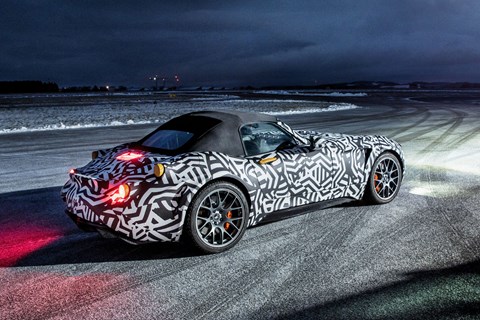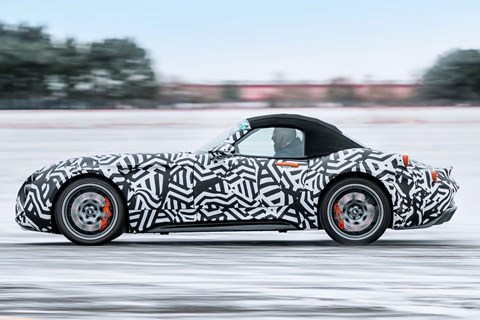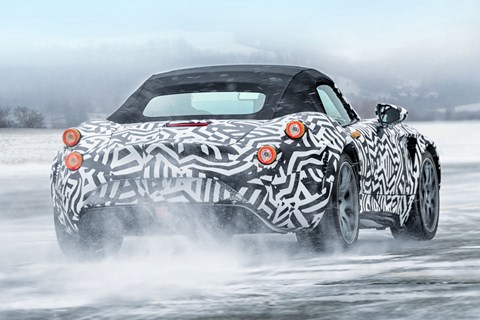► ‘Project Thunderball’ features two electric motors…
► … and a massive 93kWh T-shaped battery pack
► Combined output of 670bhp and 811lb/ft of torque
In March 2022, the German sports car manufacturer Wiesmann announced it was returning to the market with a pure-electric convertible codenamed ‘Project Thunderball.’ It’s the first new car from the brand in eight years – and it’ll soon become a more compact alternative to performance EVs such as the Porsche Taycan and Tesla Model S.
Reservations for the Wiesmann Project Thunderball are open now. You can pre-order one from the company’s website – but only if you have some very deep pockets. Prices start from €300,000, which works out at around £260,000 once you do the conversion.
When Project Thunderball broke cover earlier this year, Wiesmann was very secretive about its performance specs, but the company has now started to drip-feed us information about the car’s powertrain, targeted acceleration times and range figures. And the early signs suggest its big-name rivals will have a fight on their hands.

Thunderball is propelled by two electric motors with a combined output of 670bhp and 811lb/ft of torque. Wiesmann says that should be enough for a 0–62mph time of 2.9 seconds, which would make Thunderball fast enough to keep pace with the flagship Porsche Taycan Turbo S.
The electric motors will be powered by a 93kWh battery pack. Wiesmann hasn’t yet homologated Thunderball’s maximum range figure, but the brand says it’s expected to top out at 310 miles. The car will also operate on an 800-volt electrical system and will be compatible with ultra-fast 300kW DC rapid chargers. If you haven’t got a charger that fast nearby (which is highly likely given the state of the UK’s charging infrastructure), you can fall back on Thunderball’s 22kW onboard charger.
Wiesmann has also designed a unique five-step regenerative braking system, which is controlled via a pair of paddle shifters mounted on the rear of the steering wheel. The idea is to make the electric powertrain feel a little more like a combustion engine and encourage the driver to shuffle between the regen modes like gears in an ICE car’s transmission. Wiesmann says it makes the driving experience more engaging.
Platform and packaging
Project Thunderball’s impressive performance and range figures are thanks in part to its low kerb weight. Wiesmann says its new roadster tips the scales at a mere 1700kg, thanks to its carbon fibre body. That’s very little for an electric car. For comparison, the similarly powerful Tesla Model S and BMW i4 weigh more than two tonnes each, giving Wiesmann’s car an advantage right from the off.
Wiesmann has also packaged the car intelligently to achieve the best weight balance. The seats are mounted as far towards the rear axle as possible, while the battery pack is T-shaped and extends into the central tunnel between the driver and passenger.
Roheen Berry, CEO of Wiesmann, commented on the company’s revival. He said: ‘The continued development of Project Thunderball is bringing Wiesmann ever closer to the goal of producing what will be the world’s most exciting electric sports car.

‘The roadster will blend our bespoke cutting-edge powertrain technology with Wiesmann’s trademark German engineering excellence. We are putting the emotion back into EVs. Which is why technology has been a key part of this project, creating a vehicle that not only has the stunning looks of a true Wiesmann, but also drives like a world-class sports car.’
It seems Wiesmann’s fan base is keen to see the brand return, too. Berry continued, saying: ‘We have had an enthusiastic response from customers. Since opening the reservations list at the end of September, we have ¾ of the first year of production slots allocated, proof that they are just as excited about the new technology in Project Thunderball as we are.’
Where will Project Thunderball be built?
Project Thunderball will be pieced together at Wiesmann’s facility in Dulmen, Germany. The brand’s previous cars were all hand-built, with each taking 350 man-hours to complete. We expect this tradition will continue throughout the company’s transition into the electric era, offering buyers a similar level of customisation options.
As an aside to its electric sports car project, Wiesmann has also announced that the company is once again controlled by its founder, Roheen Berry. He said: ‘As the automotive industry undergoes its biggest revolution in a century, there can be no better time to announce the return of a refreshed, reborn and recharged motoring icon.
‘Thunderball will continue Wiesmann’s reputation for setting the standard for performance, craftsmanship and sheer enjoyment. With its unequivocal style, this is the Wiesmann fit for the 21st century, and this is just the beginning.’
